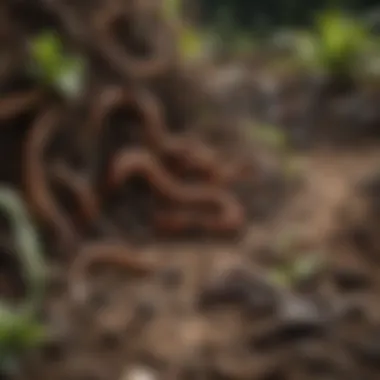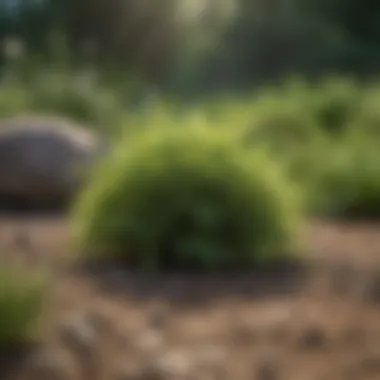Transform Your Weedy Yard into a Pristine Landscape


Intro
A yard overrun by weeds does not simply detract from its aesthetic value; it can signify deeper issues regarding your local ecosystem and soil health. Such challenges threaten the potential of a outdoor space. Therefore, transforming this landscape becomes essential not only for personal satisfaction but also for broader environmental benefits.
The time has come to explore solutions to restore your weedy yard, and this begins with understanding how various practices can reclaim the space and revitalize its soil.
Overview of the Topic
In many regions, yards become dominated by unwanted vegetation. This situation may arise from a combination of poor soil health, lack of attention, and regional plant invasiveness. The weeds that fill these lawns often compete aggressively with native plants, robbing essential nutrients from the soil. By addressing these factors, homeowners can unleash the hidden potential of their property.
Background
For many people, the yard is an extension of their home. Unfortunately, a weedy yard can invite a sense of defeat. Weeds affect not only the aesthetic quality of the property but also land health. They diminish biodiversity, affect water retention, and monopolize the nutrients that other plants need. This article highlights the practical steps necessary to reclaim and enrich one’s outdoor space sustainably.
Current Status and Challenges
The contemporary state of residential landscaping too often showcases yards plagued by invasive weeds and poor soil conditions. Many homeowners face a barrage of frustration when attempting to manage unruly vegetation.
- Unsustainable lawn care practices complicate the situation further. Over-reliance on chemical herbicides harms beneficial soil microorganisms. This methodology often creates a vicious cycle of weed proliferation as fine-tuned ecosystems break down.
- Additionally, climatic factors exacerbated by climate change can amplify these issues. Drought conditions weaken the resilience of healthy plants, providing fertile ground for weeds to gain an upper hand.
“Understanding the root causes of weed growth is paramount if one desires a transition from weed-infested yards to true verdant landscapes.”
Sustainable Solutions
Adopting sustainable landscaping techniques is key to overcoming current gardening challenges. Here are a few effective strategies to consider:
- Soil Assessment: Begin by assessing your soil’s health. A simple pH test kit can gauge its composition. From there, necessary amendments can be added to enrich the soil.
- Natural Weed Control: Instead of using chemicals, consider organic traditions like mulching or planting companion flowers to suppress weeds naturally.
- Diverse Plant Choices: Introduce a wider variety of native plants that can coexist harmoniously. Native vegetation tends to rely less on fertilizers and contribute instead to local ecosystems.
Case studies abound where homeowners have successfully enacted these strategies, resulting in healthier gardens that radiate serene vitality. Communities are seeing benefits when engaging in holistic approaches to yard care.
Impact and Importance
The consequences of yards neglected by responsible practices extend beyond the garden gate. Vibrant landscapes directly influence local ecosystems and broadly impact community health.
Each yard holds a role in policing erosion and maintaining a healthy watershed. Every time a homeowner reinvests in nature through sound landscaping—whether adopting practices for improved soil or implementing sufficient biodiversity—they contribute positively.
Additionally, engaging in sustainable gardening techniques fosters future generations of conservationists. It cultivates awareness about the balance and care for our ecosystem.
Overall, these efforts lean towards a more sustainable future for homeowners and wildlife alike. Hence, the significance of a pristine landscape reverberates widely; this landscape ripples outward in improving our impaired ecosystems.
Understanding the Weedy Landscape
A weedy landscape can significantly detract from the visual appeal of a home environment. Various species of weeds might crowd, suffocate, and dominate your turfgrass and other desirable plants. In this section, we aim to reshape your comprehension of such landscapes. It is vital to first identify and understand the weeds present in your yard before striving for a transformation.
Overall, understanding the weedy landscape allows for smarter management of your outdoor space. Knowledge of the specifics equips you to engage in more effective techniques for extraction and control. The next step involves identifying common weeds you may find in your area.
Identifying Common Weeds
Weeds are often defined as unwanted plants that grow in gardens or lawns, competing for resources. It is essential to distinguish between perennial and annual weeds. Perennial weeds, such as dandelions, tend to reappear year after year, while annuals, like crabgrass, grow, flower, and die within one season. Educating oneself on their characteristics can greatly improve management effectiveness.
Here’s a list of common weeds:
- Dandelion
- Thistle
- Crabgrass
- Clover
- Wild violets
To recognize these weeds, one must observe their leaf shape, growth patterns, and flowering times. Keeping a field guide or an app may help in swiftly identifying these largely uninvited guests in your yard. Identification leads to the realization of any patterns among weed infestations, fundamental for the planning of control strategies.
Impact of Weeds on Ecosystems
The presence of weeds in an ecosystem can have far-reaching consequences. For example, they may hinder the growth of local flora by absorbing essential resources like sunlight, moisture, and nutrients. Not only do they thrive in disturbed environments, but some species can also possess allelopathic properties. They release chemicals into the soil that inhibit the growth of nearby plants.
Weeds can thereby limit biodiversity, which is critical for ecosystem stability. They can alter soil structure by affecting organic matter cycling. Research indicates that this phenomenon can lead to accelerated erosion and negatively impact overall soil health.
Therefore, managing weeds is not only an issue of aesthetics but an urgent need to safeguard ecosystem functions and services you rely upon in your yard.


The Importance of Soil Health
Soil health plays a critical role in transforming a weedy yard into a lush landscape. Healthy soil supports plant growth, contributes to ecosystem resilience, and improves the overall quality of outdoor space. If your soil is rich in nutrients, it can naturally suppress weeds and promote beneficial plant species. Prioritizing soil health is an imperative starting point for successful landscaping.
There are several specific benefits to focusing on soil health in your garden. First, nutritious soil increases water retention, reducing the need for frequent watering. This directly contributes to a more sustainable approach. Second, healthy soil fosters a robust microbial community that breaks down organic matter and recycles nutrients for plants. Lastly, investing time in soil health often leads to less reliance on chemical fertilizers and herbicides, which can harm the environment.
Ignoring soil quality may gift various issues. Weeds thrive in nutrient-poor or imbalanced soil, and by not addressing these qualities, the struggle against invader plants becomes more challenging. This is why addressing the foundation—the soil—holds utmost importance in guiding the project toward success.
Understanding Soil Composition
Soil is a complex, living ecosystem made up of minerals, organic matter, air, and water. Understanding the composition aids in assessing its health and determining necessary amendments to reach desired conditions. Broadly, soil can be broken down into three key components:
- Mineral Particles: Comprising sand, silt, and clay, these contribute to drainage and nutrient availability.
- Organic Matter: Comprising decomposed plant and animal material, organic matter enhances soil fertility and structure.
- Soil Biology: Contains bacteria, fungi, and macrofauna. They all aid in nutrient cycling and organic matter breakdown.
These components interact in multifaceted ways, thus ensuring a balanced soil composition is essential for successful gardening practices. When soil structure is optimized, it encourages root development and plant health, urging ideas about how to achieve a pristine landscape.
Testing Your Soil
Before taking steps to improve soil health, it is wise to assess the current state through soil testing. This process involves extracting soil samples for laboratory analysis. Here’s how to conduct soil testing effectively:
- Choose Appropriate Locations: Collect samples from various spots within your yard to get a comprehensive understanding.
- Use Clean Tools: Ensure that all tools used for sampling are clean to prevent contamination.
- Send to a Laboratory: Many agricultural extension services offer testing. Results will include pH levels, nutrient content, and organic matter %, guiding you in making informed decisions.
- Interpret Results: Use findings to evaluate nitrogen, phosphorus, potassium, and pH. Recommendations for amending soil will often accompany reports and can guide efforts about further improvements.
Conducting regular soil testing can save money and time, helping refine landscaping strategies on your property. It makes for smarter decisions, supporting healthier gardens while mitigating resources spent on unproductive weed control.
“A well-informed gardener turns the soil in their favor rather than against them.”
A Step-by-Step Approach to Weed Control
Weeds can interfere with the growth of a well-planned landscape. Using a step-by-step approach is essential to both eliminate weeds and promote healthy plant communities. Here, we will delve into the practical techniques available to genuinely address this issue. Implementing effective weed control strategies not only fosters a more enjoyable outdoor space but also preserves and enhances the ecological balance of your yard.
Manual Removal Techniques
Manual removal of weeds can be helpful, especially in smaller areas. This straightforward technique involves pulling out weeds by their roots. It is vital to do this after rainfall or irrigation when the soil is softer. Here are key points to consider for manual removal:
- Timing: Removing weeds during their young growth stage increases success.
- Tools: Simple tools like gloves and a weeding fork can make this task easier.
- Technique: Grip the base of the weed close to the soil and pull straight up to maximize root extraction.
This method, while labor-intensive, greatly reduces the chance of regrowth. Moreover, manual removal does not introduce any chemicals into the environment.
Chemical vs.
Organic Herbicides
The choice between chemical and organic herbicides often depends on personal values or budget constraints.
- Chemical Herbicides: These products often yield rapid results, but possible long-term side effects can impact soil and surrounding plant life. Skilled application is crucial as misuse can harm beneficial organisms.
- Organic Herbicides: Encouraging safer practices, organic method typically relies on natural ingredients. They may take longer before yielding visible results, making consistency integral for success. Always read application instructions to maximize efficacy.
Considering local ecosystems is vital; different regions may have differing regulations about herbicide use. Hence, consult applicable governance or local guidelines regularly.
Mulching as a Preventative Measure
Mulching offers multiple advantages in weed control, serving as both a preventative and a protective measure. Covering garden beds with mulch reduces the sunlight available for weed germination, hindering their growth. It has additional merits:
- Soil Moisture: Mulch conserves soil moisture, reducing the need for frequent watering.
- Temperature Regulation: It helps regulate soil temperature, benefitting plant roots.
- Aesthetic: It enhances the visual appeal of a garden space.
To achieve the best mulching results, choose organic mulches, like wood chips or straw. They break down into beneficial organic matter over time, thereby enhancing soil health.
Enhancing Soil Quality
Enhancing soil quality is central to transforming a weed-infested yard into a healthy and vibrant landscape. Healthy soil acts as a foundation for robust plant growth. It not only amplifies plants’ health but it also plays a crucial role in water management. Properly enhanced soil filters rainwater and cycles nutrients effectively, contributing to a sustainable ecosystem.
Improving soil quality involves the integration of organic matter, nutritious components that improve soil structure and promote beneficial microorganisms. These processes not only assist in retaining moisture and nutrients but also bolster the ground’s“ tension against weed invasion. Effective steps must include understanding local needs and nutrient deficiencies.
Additionally, crop rotation is an important method of improving soil health. Varying the type of plants grown in a specific area over time reduces pest and disease build-up, minimizing the need for chemical interventions. This method also encourages a balanced soil nutrient profile, making the area less susceptible to weedy overgrowth. Ensuring these aspects are tackled thoughtfully makes it possible to develop and maintain green spaces that are not just aesthetically pleasing, but ecologically resilient.


"The health of your soil determines the health of your landscape."
Incorporating Organic Matter
Incorporating organic matter into your soil is crucial for many reasons. Organic materials such as compost, aged manure, or leaf mulch provide essential nutrients for plants while enriching the soil’s structure. They encourage microbial life, which is vital for nutrient breakdown and availability to plants.
Organic matter can improve air and water movement within soil. This is important because well-structured soil retains moisture during dry periods while allowing excess rainwater to drain properly. Both aspects contribute to healthier plant roots, creating more robust landscapes that resist pest and weed encroachment.
- Benefits of Organic Matter:
- Enhances nutrient availability.
- Improves water retention.
- Supports soil organism variety.
Though incorporating organic matter is simulate and a significant step, you need to be careful with the quantity and frequency. Adding too much compost at once can lead to nutrient imbalances or even root burn. It is best to gradually enrich your soil over this process.
Implementing Crop Rotation
Implementing crop rotation is a widely praised technique in agriculture that reduces soil nutrition depletion and pest issues. By alternating crops seasonally, that meaning commonly rotating between legumes, grains, and cover crops, you allow the soil to cycle its nutrients.
This beneficial impact on the soil stems from the specific requirements that different plants have when it comes to nutrients. For instance, legumes enhance nitrogen levels in the soil, whereas deep-rooted plants can pull up nutrients and moisture from greater depths. Areow times moving plants reduces like at sead the likelihood of weed species which favor some plants establishing, hindering a full lush compare.
Factors to consider when implementing crop rotation include:
- Seasonal climate conditions: Adapt crops to suit climatic changes.
- Specific plant requirements: Understand nutrient needs and compatibility of plants.
- Weed types known: Awareness can drive rotation decisions.
Though crop rotation is more commonly associated with large-scale agriculture, homeowners can adopt parts of this method in their garden layouts. Knowing how these approaches enhance soil quality can lead yors to a lovely artefact.
Choosing Sustainable Landscaping Options
Creating a sustainable landscape means selecting plants and practices that support the local ecosystem. It reduces the need for chemical interventions and minimizes water consumption while promoting biodiversity. Sustainable landscaping takes into account the specific needs of a region, reflecting the native environment in which a home resides. This approach leads to resilient ecosystems that not only look great but also provide essential resources for local wildlife.
The benefits of choosing sustainable landscaping options include:
- Reduced Maintenance: Native plants often require less water and fewer fertilizers compared to non-native species.
- Biodiversity Support: Creating habitats with native flora encourages various wildlife, aiding in pollination and natural pest control.
- Soil Health Improvement: Establishing a diverse plant community can enhance soil quality and structure.
- Water Conservation: Many sustainable landscapes use drought-resistant plants to minimize water usage.
Native Plants for Your Yard
Using native plants is a fundamental component of sustainable landscaping. These plants are well-adapted to local soils and climates, promoting a natural balance in your yard. Native species tend to be more resistant to local pests and diseases. This reduces the need for chemical treatments, thus preserving the health of your garden and surrounding environments.
When selecting native plants, consider the following:
- Temperature and Climate: Ensure the chosen plants are suitable for your area.
- Soil Type: Different native plants thrive in various soil conditions. Testing your soil can help determine the best options.
- Sunlight Requirements: Some natives prefer full sun, while others thrive in shaded areas. Proper placement can yield better results.
Incorporating these elements can lead to a flourishing ecosystem.
Drought-Resistant Alternatives
In regions prone to drought, choosing plants that require minimal water is essential. Drought-resistant plants are often native or adapted species that can thrive during dry spells without additional irrigation.
Consider plants such as:
- Lavandula angustifolia (English Lavender)
- Agave species
- Euphorbia tirucalli (Pencil Cactus)
- Sedum species(Stonecrop)
These plants not only contribute to a vibrant landscape but also help conserve water resources. Adopting drought-resistant alternatives will lessen your landscape's environmental impact while maintaining its beauty.
Incorporating sustainable landscaping options will not only transform your weedy yard into a lush garden but also contribute to the ecological health of your surrounding area.
By choosing native and drought-resistant plants, you play a significant role in protecting the environment and encouraging overall sustainability.
Creating an Integrated Weed Management Plan
An integrated weed management plan is essential for any homeowner seeking to reclaim a yard overwhelmed with weeds. This approach involves using several complementary management tactics to effectively minimize the impact of unwanted vegetation. The plan recognizes that no single strategy can fully eradicate weeds but rather encourages a combination for cumulative effect. Having such a plan in place means you take a thoughtful and strategic stance against weeds, which enhances your overall landscape while promoting an ecologically balanced environment.
With various methods available, you can adapt your plan based on specific situations. Consideration of local conditions, the types of weeds present, and the overall goals for your yard are all crucial to the success of this management plan.


Assessing Weed Population
A foundational step in your integrated weed management plan is assessing your weed population. You need to identify not only what types of weeds are present, but also their growth habits, and the extent to which they are spreading.
Begin by conducting a surveyed walkthrough of your yard. Observe areas where weeds thrive. Particularly focus on high-population zones, often these derive from challenges like poor soil conditions and water drainage.
Utilize the following points as a guideline during your assessment:
- Identify types of weeds: Understand the specifics of the weeds in your yard, such as whether they are annuals or perennials.
- Density of weed proliferation: Count or estimate weed plants in a designated area — this gives you a sense of how severe the population is.
- Impact assessment: Take note of how the weeds affect desired plants and overall ecosystem health.
Gathering this information supports the holistic approach required in an effective weed management plan. It provides a baseline which you can refer to as you implement and adapt strategies over time.
Setting Realistic Goals
Establishing realistic goals is a critical element of your weed management plan. Goals should be Specific, Measurable, Achievable, Relevant, and Time-bound. Striving for unrealistic outcomes can lead to frustration and further complicate your efforts.
When setting goals, consider these points:
- Short-term goals: Establish immediate targets, such as reducing visible weeds in major areas within specifics weeks.
- Long-term objectives: Aim to cultivate sustainable growth of desirable plants over a longer period. This involves gradual improvements in soil conditions and regular maintenance.
- Assess adaptive measures: Prepare to recalibrate goals based on ongoing assessments of weed populations and environmental conditions.
By ensuring your aims are aligned with the practical reality of your landscape situation, you set the stage for constructive progress and an enriching outdoor habitat.
Integrating various methods for weed control stands to improve the effectiveness while minimizing environmental disruption in your landscape.
Maintaining Long-Term Green Spaces
Maintaining long-term green spaces is essential for the overall health of the environment and helps sustain the beauty and functionality of outdoor areas. An organic, flourishing landscape supports local wildlife, improves air quality, and offers a haven for biodiversity. This aspect of landscape management integrates practices that ensure your weedy yard evolves into a vibrant, cohesive ecosystem. Understanding this importance lays the groundwork for effective strategy in sustaining these desirable yard transformations.
Regular Monitoring and Maintenance
To keep a landscape healthy, regular monitoring and maintenance practices cannot be overlooked. These are essential not just at the beginning stages of establishing your green space, but as part of a continuous cycle. By making small, consistent efforts, yard owners can avoid larger issues before they arise. Here are some key practices to integrate into your routine:
- Weed Patrol: Regularly check for emerging weeds and remove them while they are manageable. Documentation during this process helps in understanding which weeds tend to reoccur.
- Health Checks: Observe plant both foliage and root systems. Noticing changes early can lead to better intervention when problems arise.
- Soil Tests: Conduct periodic tests to gain insight on soil nutrients and pH levels. Understanding the soil condition goes a long way in making appropriate amendments.
In this process of consistent oversight, you may discover which native plants thrive and contribute positively to that landscape.
Proper management practices create a more resilient green space that leads to long-term ecological benefits.
Adapting to Climate Changes
Climate change poses new challenges to sustainable landscape maintenance. It’s a critical consideration for long-term management. As weather patterns fluctuate, understanding local climate changes will facilitate informed decisions on plant selection and care.
Consider the following strategies to adapt:
- Diversity in Plant Life: Utilizing a variety of plant species is key. Mixing plants can help mitigate risks associated with climatic stresses; different plants respond uniquely to varying weather.
- Water Conservation Measures: During hot, dry spells, invest in rain gardens or xeriscaping approaches that use drought-resistant plants to conserve water.
- Cover Cropping: In certain seasons, implement cover crops to enrich the soil during fallow times. Crops like clover can improve fertility and manage soil erosion.
By staying attentive to climate variations throughout the seasons, landscapes can be steered in directions that not only foster growth but also buffer the impacts of climate shifts, making ecosystems more robust._
The End and Next Steps
A positive transformation of a weedy yard into a beautiful landscape can profoundly impact the aesthetic and ecological aspects of a home. Understanding the strategies presented in this guide is essential for homeowners seeking to revitalize their outdoor spaces and support environmental health. This final section reinforces the key points made, and highlights actionable steps for sustained effort.
Taking a moment to reflect on the progress achieved is crucial. Achievements can often be overlooked in the pursuit of perfection. Each small change contributes to a larger goal, creating healthy soil and eradicating stubborn weeds. Remember either enduring weed problem while taking proactive measures to address and mitigate ongoing challenges that arise in this journey.
Reflecting on Progress
Assessing what has been accomplished with your yard is an important step. Take time to document changes—these can include improved soil quality, celebrity native plants flourishing, or the effective cessation of weed growth. Investing in tools like a landscape diary or an app can help noting key shifts and locations of major improvements.
Here are several pointers for this evaluation process:
- Compare your lawn's current state to your initial conditions.
- Look out for signs of healthy soil and plant diversity.
- Check weed growth trends to gauge effectiveness of your management plan.
Involving family members can add value. Share their experiences tracking changes might also encourage engagement with the yard's updates.
Resources for Further Learning
Knowledge in this area doesn't stop here. Numerous resources can be useful for maintaining and enhancing the procedures discussed. Relying on well-curated knowledge aids in enhancing sustainable landscapes effectively. Explore these options:
- Wikipedia offers extensive material on various plants, herbicides, and gardening techniques: en.wikipedia.org
- Visit Britannica to gain insights on ecologically significant practices: britannica.com
- Engage with like-minded individuals on gardening and conservation at Reddit: reddit.com
- Join channels or follow groups that discuss environmental sustainability on Facebook: facebook.com



